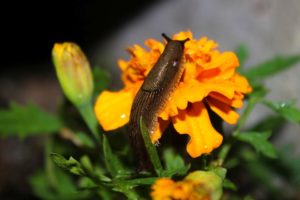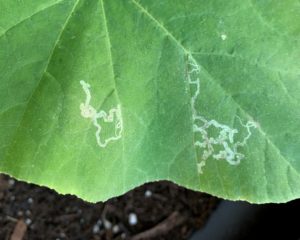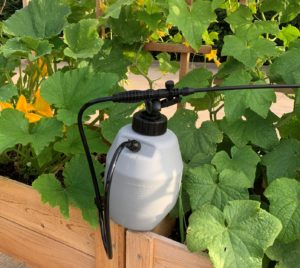Spider mites are not insects. Instead, they are members of the arachnid family, as are spiders and ticks. They are so small that they are difficult to see without a magnifying glass. While they are almost invisible, the damage they inflict is not. This garden pest feeds on the leaves of over 200 plant varieties, interrupting photosynthesis, which weakens and ultimately kills the plant.
There are approximately 1,200 species of spider mites, the most common of which is the two-spotted spider mite, also known as the red spider mite.
Life Cycle of the Two-Spotted Spider Mite
Spider mites undergo five stages of life: egg, larva, protonymph, deutonymph, and adult. Adult mites can vary in color from yellow to yellow green, to green brown. They may turn orange, red, or red-brown during the fall or in drought conditions.
Adult spider mites lay about 100 clear or milky spherical eggs during a three-week period. The fertilized eggs become female spider mites, and the unfertilized eggs become male. The eggs are capable of overwintering in plants.
The larvae have six legs and are colorless. Once hatched, they immediately begin to feed on plant tissue. As they mature, they will change color and develop two dark spots.
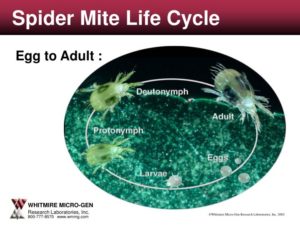
The protonymph stage begins when the larvae reach a certain size, at which time they develop two more legs. When the protonymphs increase in size, they will transition to the next stage, deutonymph. Both protonymphs and deutonymphs can spin webs.
The last stage of development occurs when the deutonymph molts into an adult. In this stage, the spider mites can reproduce sexually or asexually. The entire life cycle takes about two weeks, although in warmer environments, the process is accelerated to about one week. This rapid life cycle is what makes these tiny pests so formidable. They may be small, but as they multiply, so does the damage.
Damage
Spider mites suck on plant sap, removing vital chlorophyll. In the process, they inject toxins into plant tissue. Although the mites feed on the underside of leaves, the damage appears on the upper side as yellow, white, or brown stippling. Leaves may also appear silver or bronzed Fine silver or dusty webbing will be noticeable on the underside of leaves and between stems. If you look closely, you may also see spider mite movement, which looks like tiny moving dots.
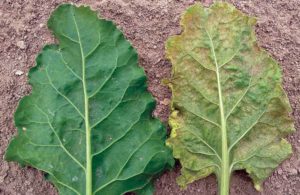
Where Do They Reside?
Spider mites may be introduced into your indoor or outdoor garden via plants purchased from nurseries, big box stores, etc. Therefore, it is important to carefully inspect all plants, especially the underside of leaves, before purchasing them.
But spider mites can also enter your green space via the wind or by hitchhiking onto shoes or clothing. Their migration from one part of your garden to another can also be facilitated by contaminated garden tools and equipment.
These tiny arachnids prefer warm, dry conditions and, in particular, plants that are stressed. Thus, it is important to keep plants properly hydrated and healthy so that they will be less vulnerable to an infestation.
Spider mites also take advantage of plants like rosemary, thyme, and oregano, which prefer drier conditions. Marigolds are also prone to spider mites. In addition, soils that have an excess of nitrogen attract the micro pests due to the types of proteins that are produced in a nitrogen-rich environment. Interestingly, spider mites are also fond of hydroponic systems, especially those that incorporate soil. Even though this type of environment is more humid, spider mites find the temperature very inviting.
If you suspect your plant has spider mites, hold a piece of white paper underneath the leaves and gently shake the plant. If there are spider mites, they will fall on the paper. You will have to look closely because they appear as small specs.
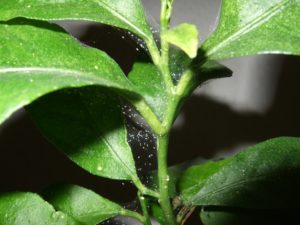
This article contains affiliate links. If you make a purchase using one of these links, I will receive a very small commission at no additional cost to you, and it will help me maintain this website. Rest assured, I only recommend products I actually like!
Treatment
Water – A strong stream of water can easily dislodge spider mites from a host plant. Although it will not remove all of them, it is a good place to start.
Insecticidal soap works by penetrating the arachnids’ outer skin and drying it out. Additionally, the soap may suffocate them.
You can make an organic insecticidal soap by mixing 1 to 2 teaspoons (2.5 to 5 ml) of a Castile soap like Dr. Bonner’s or Dr. Wood’s into a sprayer with one quart of water (or 1 tablespoon in one gallon of water). Do a test spray on one leaf and wait 24 to 48 hours to see if the plant responds negatively. If it shows signs of damage, dilute the mixture and perform another test spray. Spray the entire plant, including the underside of leaves, in the cool of the evening or early in the morning. Otherwise, the combination of the spray and sunlight could burn the plant. Repeat every 7 days as needed.
Essential Oils – A 2017 study found that essential oils were effective at combating spider mites. Chamomile, coriander, spearmint, and rosemary essential oils proved to be the most effective against eggs and adults. Anecdotally, good results have also been reported using 1/2 to 1 teaspoon of peppermint essential oil, with a few drops of a Castile soap in one gallon (3.75 liters) of water using a one gallon sprayer. Be sure to perform a test spray. If necessary, dilute the mixture and test again. Repeat once every seven days as needed.
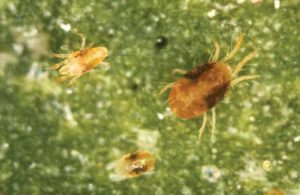
Neem Oil is an effective insecticide and miticide. It works by repelling pests, disrupting their ability to eat, and by suffocating them. Be sure to choose a neem oil that is pure, cold-pressed, and contains the naturally occurring compound, Azadirachtin, as this is the most effective type of neem oil. This is the brand I use.
Make your own neem oil spray by adding 1 to 2 teaspoons (5 to 10 ml) of neem oil with 1/2 to 1 teaspoon (2.5 to 5 ml) of a Castile soap like Dr. Bonner’s and 1 quart (.95 liters) of lukewarm water in a sprayer. Shake well. Do a test spray on one leaf and wait 24-48 hours. If there is an adverse reaction, dilute the recipe and retest. Apply the spray to all surfaces of the plant, especially the underside of leaves. Repeat once a week as needed.
AzaMax is an option for those who find spider mites in hydroponic systems. Azamax contains Azadirachtin, the primary ingredient found in neem oil.
Companion Plants can help in the prevention and fight against spider mites. Dill, coriander, pyrethrum, garlic, chives, onion, rhubarb, leeks, chrysanthemums, cilantro, and Shasta daisies, work by either repelling spider mites with their aroma or by attracting the natural predators of the spider mites.
Beneficial Insects that will attack spider mites include lacewings, green lacewings, predatory thrips, and ladybugs.
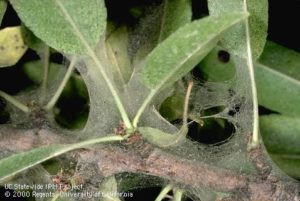
If the plant has a serious infestation, it may be best to remove the plant and throw it away. Do not compost it.
Spider mites are tiny but formidable garden pests. The sooner you act to eradicate them, the better, as rapid multiplication is their secret weapon.
Thank you for reading this article! If you found it helpful, please consider sharing it with others via email and social media!

